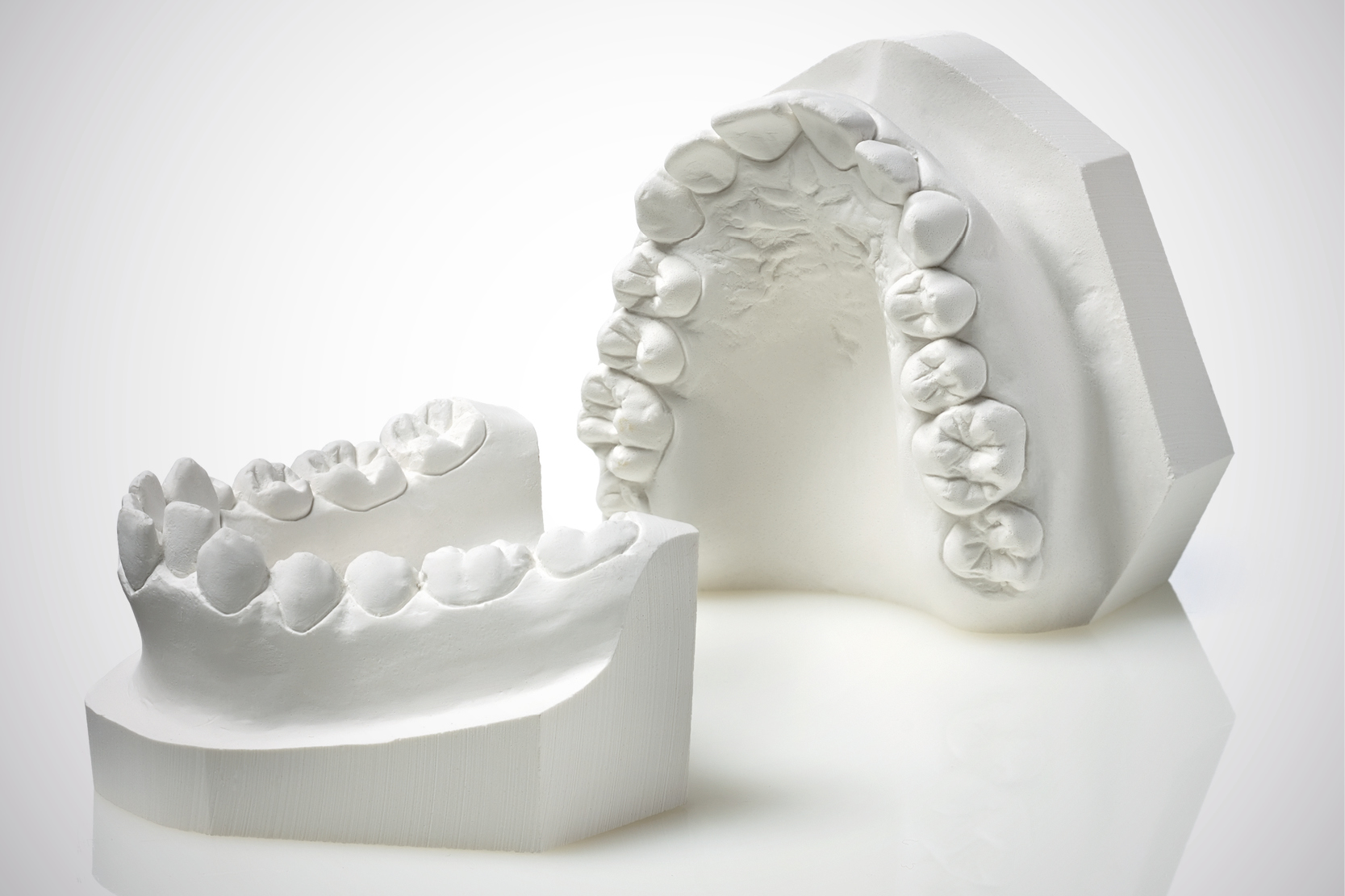
Gypsum is a mineral form of calcium sulphate dihydrate. It has been known for millennia and has been used for many purposes. 5000 years ago, the ancient Egyptians used to fire “plaster of Paris” in open air furnaces. They then added water to make cement for assembling the blocks of the pyramids (e.g. the pyramid of Cheops) [1]. The ancient Greeks used gypsum in the construction of their temples [2].
Gypsum is found in nature in the form of compact masses. It is extracted from deposits and quarries as mineral gypsum before being processed and refined for use in dentistry. Gypsum can also be obtained synthetically, as a by-product of the industrial synthesis of phosphoric acid [3].
Gypsum in dentistry
In both mineral and synthetic form, gypsum is an extremely useful if not essential material for the dentist and dental technician [4]. Its usefulness is explained by the ability of semi-hydrated gypsum powder to absorb water and assume stable, long-lasting shapes.
Dental gypsums are regulated by ISO standard 6873:2013 [5] which classifies different types and specifies the requirements for gypsum-based dental products.
In dentistry, gypsum is mainly used to produce study or diagnostic models, and working or master models as well [6]. Study models are used to assess clinical cases requiring prostheses or orthodontic devices, while working models are the models of arches on which wax-ups of prosthetic frameworks or orthodontic devices are made.
How many types of gypsum are used in dentistry?
Gypsums are used for various purposes and clinical applications in dentistry. We therefore need to distinguish between different types in accordance with the ISO standard mentioned above [4]:
- Type I gypsums are dental plasters for impressions. This type is also referred to as plaster of Paris and is used in impression making. They consist of fine-ground natural gypsum with all impurities removed. They are produced from calcium sulphate dihydrate, which is heated to around 110°C until it becomes a semi-hydrate.
- Type II gypsums are dental plasters for mounting and models. These products are suitable for making study models and models for mounting in an articulator. Gypsums of this type are also used as fillers in flasks.
- Type III gypsums are dental stones and intended for the production of high-strength models. They have an average porosity of 25% and are calcined at a temperature of 125°C in the presence of water vapour.
- Type IV gypsums are high-strength dental stones and are used to make models that must preserve the details of an impression for an extended period of time. They are therefore used mainly to make models for fixed and combined prostheses. They are industrially synthesised, artificial substances.
In dentistry, gypsums can be used as [4,5]:
- impression materials for edentulous arches;
- impression materials for bite registration keys (for mounting models in an articulator);
- models;
- binding agents for silica in investments (gold and nickel-chrome alloy castings);
- investment materials for welds;
- flask moulds (negatives for the production of removable total and partial prostheses).
Gypsums are only used to make impressions of edentulous arches. This is because gypsum is extremely rigid and non-elastic. It can be used to take impressions of edentulous arches only thanks to the absence of interdental spaces and significant rigid undercuts [7].
Examples of dental applications for gypsum
Impressions can be taken for the purpose of producing prostheses even if implants are present in a totally edentulous arch provided the implants are parallel with each other and not at an excessive inclination. In these procedures, transfers can be combined into a single block that is extremely rigid thanks to the use of gypsum, allowing high levels of accuracy to be achieved in the fitting of implant prostheses.
The rigidity of the system prevents the transfers from moving during removal of the impression from the mouth and during the production of the model [8–10].
Gypsum bite registration keys
Gypsum bite registration keys can be produced by injecting liquid gypsum into the patient’s vestibule to take simultaneous impressions of the vestibular surfaces of antagonist teeth and the interocclusal portion of the arches [11].
This allows the dentist and the technician to mount the patient’s models in the articulator in a way that is far more predictable than with materials like wax, for example, which is quite easy to deform. In such applications, the rigidity of the gypsum proves fundamental for the correct articulation of the models.
Gypsum in the lost wax casting
Gypsum can also be used in lost wax casting [12,13]. This technique requires the preparation of a mould made from a refractory material, i.e. a material that does not decompose at high temperatures, to surround the wax model. Molten metal is then poured into this mould, causing the wax to evaporate and flowing into the spaces vacated by it.
Dental technicians select the most suitable investment material on the basis of the type of restoration and the metal alloy used to produce the prosthetic framework. The logic behind their choice depends on the relationship between the coefficients of contraction of the alloy and the coefficients of thermal and hygroscopic expansion of the investment binding agent.
Calcium sulphate binder investments
Investments containing calcium sulphate binders are used to produce the refractory moulds into which low fusion temperature (<1200 °C) alloys are poured and in the casting of total prosthesis bases and metallic frameworks for removable partial prostheses [4].
Finally, again in dental labs, gypsum is also used to prepare the flasks used to transform wax models of total prostheses into resin total prostheses [14].
In other words, gypsums are useful in the finalisation of removable prostheses, after registration of the vertical and centric relations and fitting trials, when a final total or partial removable prosthesis has to be produced. In such situations, gypsum can be used to make the negative mould of the prosthesis for flasking.
High performance products for gypsum modelling
It is clear that even today gypsums are still essential to the dentist and dental technician alike. The digital technologies that are now appearing, like 3D printing, represent alternatives to gypsum-based procedures, but the latter are far more economical and still more accurate in the production of dental prostheses [15]. On top of this, gypsum is the only material able to produce a physical model of a patient’s anatomy that is accurate, precise and dimensionally stable over time.
Zhermack supplies a range of high performance products for the production of gypsum models. Zhermack’s extensive Elite Dental Stones range boasts low expansion, even after 48 hours, and satisfies the needs of dental technicians in the production of fixed and removable prostheses.
Types 3 and 4 from the Elite Dental Stones range offer different specific solutions for the production of antagonist or diagnostic models and for the preparation of master models.
Bibliography
[1] Hemeda S, Sonbol A. Sustainability problems of the Giza pyramids. Herit Sci 2020;8:8. https://doi.org/10.1186/s40494-020-0356-9.
[2] Gale NH, Einfalt HC, Hubberten HW, Jones RE. The sources of Mycenaean gypsum. J Archaeol Sci 1988;15:57–72. https://doi.org/10.1016/0305-4403(88)90019-2.
[3] Tian B, Cohen MD. Does gypsum formation during sulfate attack on concrete lead to expansion? Cem Concr Res 2000;30:117–23. https://doi.org/10.1016/S0008-8846(99)00211-2.
[4] Breschi L, et al. Materiali e tecnologie odontostomatologiche. (2011): 95-117. n.d.
[5] https://www.iso.org/standard/54423.html n.d.
[6] Kim J-H, Im Y-W, Oh S, Kim H-W, Lee J-H, Lee H-H. Characterization of an anti-foaming and fast-setting gypsum for dental stone. Dent Mater Off Publ Acad Dent Mater 2019;35:1728–39. https://doi.org/10.1016/j.dental.2019.08.110.
[7] Woelfel JB. Contour variations in impressions of one edentulous patient. J Prosthet Dent 1962;12:229–54. https://doi.org/10.1016/0022-3913(62)90061-6.
[8] Baig MR. Multi-unit implant impression accuracy: A review of the literature. Quintessence Int Berl Ger 1985 2014;45:39–51. https://doi.org/10.3290/j.qi.a30769.
[9] Baig M. Accuracy of Impressions of Multiple Implants in the Edentulous Arch: A Systematic Review. Int J Oral Maxillofac Implants 2014;29:869–80. https://doi.org/10.11607/jomi.3233.
[10] Kim S, Nicholls JI, Han C-H, Lee K-W. Displacement of implant components from impressions to definitive casts. Int J Oral Maxillofac Implants 2006;21:747–55.
[11] Rosentritt M, Siavikis G, Behr M, Kolbeck C, Handel G. Approach for valuating the significance of laboratory simulation. J Dent 2008;36:1048–53. https://doi.org/10.1016/j.jdent.2008.09.001.
[12] Shillinburg HT, et al. Fundamentals of fixed prosthodontics. Quintessence Publishing Company, 1997 n.d.
[13] McCoy T. Lost wax casting technique for metal crown fabrication. J Vet Dent 2014;31:126–32. https://doi.org/10.1177/089875641403100214.
[14] Vafaee F, Tavakolizadeh S, Kadkhodazadeh M, Khoshhal M. Evaluation of the Effect of 2 Flask Investment Materials on Color Stability of 5 Brands of Denture Teeth. J Dent Mater Tech 2014;3. https://doi.org/10.22038/jdmt.2014.3344.
[15] Dawood A, Marti Marti B, Sauret-Jackson V, Darwood A. 3D printing in dentistry. Br Dent J 2015;219:521–9. https://doi.org/10.1038/sj.bdj.2015.914.
Do you want more information on Zhermack Dental products and solutions?
Contact us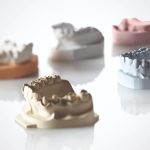
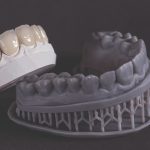
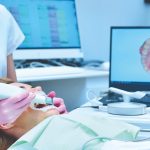
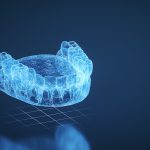

 Zhermack SpA has been one of the most important producers and international distributors of alginates, gypsums and silicone compounds for the dental sector for over 40 years. It has also developed solutions for the industrial and wellbeing sectors.
Zhermack SpA - Via Bovazecchino, 100 - 45021 Badia Polesine (RO), Italy.
Zhermack SpA has been one of the most important producers and international distributors of alginates, gypsums and silicone compounds for the dental sector for over 40 years. It has also developed solutions for the industrial and wellbeing sectors.
Zhermack SpA - Via Bovazecchino, 100 - 45021 Badia Polesine (RO), Italy.


